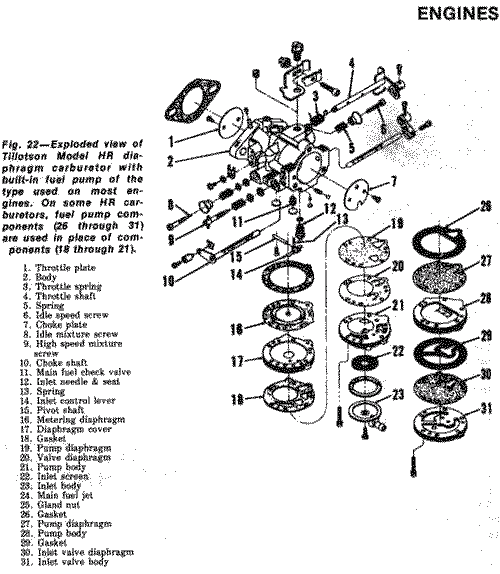|
|
|
Dead
Sled Wrenchers New England
Tech
Rebuild a Tillotson HR Carb
|
So You've got an old Ski-Doo or Arctic
Cat or other sled that uses a Tillotson carb and either the sled doesn't
run at all or its running poorly, and you think the carb is at fault. 2. Sparkplug is soaked with gas but does
have spark 3. Gas runs out of the carb There are 2 standard failure modes for a Tillotson HR, on a Ski-Doo single cylinder. Since single cylinder Ski-Doos is what I know thats what I'll talk about. I expect others are similar. Probably most common is no gas, generally caused by a stuck needle, a close second is gas running out of the carb which can be caused by a stuck needle or more likely a bulged welch plug under the idle jet. So the first step is to pull the carb
to start pull the fuel line(s) some carbs have a fuel return line, some
don't. Some people put pipe clamps on the fuel lines, I've used them but
I don't think its that important, especially if you're using blue fuel
line which is much more stiff than the clear. Then remove the throttle
cable. I like to tin the end of a new throttle cable with my soldering
iron before I put the cable on the sled. Tinning the cable keeps the end
from fraying and makes it much easier to put back on the carb. Some cables
will have a metal piece crimped over the end to do the same thing. If
the metal piece stays on then its great, if it falls off you were better
off tinning it in the first place. |
||
 |
|
List of tools: 1. Carb removal wrench: 3. Flat head screwdriver: 6. Couple sheets of white paper 8. Small punch or small nail. 9. Nail the same size as the welch plugs: 10. Cleaning solution: 11. Carb cleaner: 12. Rubber gloves: 13. Rebuild kit: 14. Ballpeen hammer: 15. Replacement fuel strainer 16. Replacement fuel filter 17. New fuel line 18. Fuel pickup strainer |
|
Be careful as you remove the bottom of
the carb, try to keep all the pieces together. On a Ski-Doo single cylinder,
like the type 300's HR37a there are 2 metal pieces and 4-6 gaskets in
the fuel pump segment (see diagram, parts 26-31). Now dry everything carefully try to get as much crud off the carb body as possible. Pay careful attention to the 2 metal pieces from the fuel pump they need to be perfectly clean and smooth. Any corrotion in these parts will mean trouble. I don't know if you could fill pits with JB Weld or something similar, but it might be worth a try. Once everythings clean put the seat back
with your socket, then use the screwdriver to put the highspeed jet back
in. Set one of the new replacement welch plugs from your rebuild kit into
the welch plug inset. Set the nail with its smooth head right on the welch
plug. Use the ballpeen hammer to tap the welch plug flat. You might have
to work around the welch plug but get it just flat, don't dent it in. |
||
| Get
your new mixture screws out and figure out which spring goes where and which
gets what o ring. Springs go on first, then the washer if there is one,
then the o ring, then screw that all into the carb. Now match up the gaskets from your kit to the ones you removed from your carb. Put them all back into the carb the way you took the other ones out. They'll only fit one way as long as you've got them right side up. The metal pieces also only fit one way. Once all the gaskets and metal pieces are in there put the screws back in, make sure they're all reasonably tight but not super tight. Screw on a new fuel strainer, remount the carb with the replacement block gaskets. |
A
note on gasket goop: I never use any gasket goop in a carb, if somethings warped badly enough that it won't fit tight without some gasket goop the carb is too badly beat to be rebuilt, replace it. Used carbs can be found on the web pretty easily. |
|
|
Most HR carbs are mounted with a spacer block that the vacuum which actuates the fuel pump flows through. Make sure the small hole in the spacer block isn't obscured and is lined up with the little hole in the cylinder. Make sure the holes in the gaskets here fit right too. You can get away with using the old gaskets but your kit came with new ones so use 'em. Some carbs have a vacuum line that runs
from somewhere on the engine to the carb, replace this with a new piece
of line, its usually normal 1/4" fuel line. This is a good time to replace your fuel lines if the old ones are at all questionable. Its also a good time to put on a primer. Put in your replacement fuel filter unless you've recently put in a new one. Replace the tank strainer now if yours was cruddy. A freshly rebuilt carb on an engine that doesn't have a primer is going to be an absolute bear to start because its going to have to pull gas from the tank all the way to the carb. Arctic Cat sleds with the tank in the back are real rough for this. Pour some premix down the sparkplug hole if you can to help yourself out. A primer makes this not such a big deal.
|
||